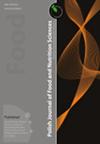Effect of Infrared Drying on the Drying Kinetics and the Quality of Mango (Mangifera indica) Powder
IF 2.3
4区 农林科学
Q3 FOOD SCIENCE & TECHNOLOGY
引用次数: 0
Abstract
Mango powder is a nutrient-dense substance that can be used directly or as a supplement in food items. However, due to the high sugar content, the removal of moisture from mango was difficult. This study investigated an infrared drying technique for removing moisture from mango pulp to produce powder products. The experiment was designed in a three-factor full factorial design with the following variables: drying temperature (70, 75, and 80°C), maltodextrin content (0, 6, and 9 g/100 g pulp), and total soluble solid content (11 and 16°Brix). The findings indicated that the Weibull model was the most appropriate for describing the moisture removal of mango pulp during infrared drying. Higher temperature and maltodextrin content, along with reduced total soluble solid content, resulted in improved quality of the mango powder. Furthermore, the optimal drying conditions for mango powder were found as 11°Brix, 80°C, and 9% maltodextrin content, which could ensure the highest retention of total phenolics (59.874%), retention of reducing sugars (71.044%), total acidity (10.141%), and retention of DPPH radical scavenging activity (65.051%). To fully benefit from the rewards of infrared drying, it is essential to establish suitable pretreatment conditions or use additives to preserve component quality.红外干燥对芒果(Mangifera indica)粉干燥动力学和质量的影响
芒果粉是一种营养丰富的物质,既可直接使用,也可作为食品的补充。然而,由于芒果含糖量高,很难去除其中的水分。本研究调查了一种红外干燥技术,用于去除芒果果肉中的水分,以生产粉末产品。实验采用三因素全因子设计,变量如下:干燥温度(70、75 和 80°C)、麦芽糊精含量(0、6 和 9 克/100 克果肉)和总可溶性固体含量(11 和 16°Brix)。研究结果表明,Weibull 模型最适合描述红外线干燥过程中芒果果肉的水分去除情况。较高的温度和麦芽糊精含量以及较低的总可溶性固体含量可提高芒果粉的质量。此外,还发现芒果粉的最佳干燥条件为 11°Brix、80°C 和 9% 的麦芽糊精含量,这可确保最高的总酚类物质保留率(59.874%)、还原糖保留率(71.044%)、总酸度(10.141%)和 DPPH 自由基清除活性(65.051%)。要充分享受红外干燥的好处,必须建立合适的预处理条件或使用添加剂来保持成分的质量。
本文章由计算机程序翻译,如有差异,请以英文原文为准。
求助全文
约1分钟内获得全文
求助全文
来源期刊

Polish Journal of Food and Nutrition Sciences
FOOD SCIENCE & TECHNOLOGY-
CiteScore
4.30
自引率
12.50%
发文量
25
审稿时长
20 weeks
期刊介绍:
The Polish Journal of Food and Nutrition Sciences publishes original, basic and applied papers, reviews and short communications on fundamental and applied food research in the following Sections:
-Food Technology:
Innovative technology of food development including biotechnological and microbiological aspects
Effects of processing on food composition and nutritional value
-Food Chemistry:
Bioactive constituents of foods
Chemistry relating to major and minor components of food
Analytical methods
-Food Quality and Functionality:
Sensory methodologies
Functional properties of food
Food physics
Quality, storage and safety of food
-Nutritional Research Section:
Nutritional studies relating to major and minor components of food (excluding works related to questionnaire
surveys)
-“News” section:
Announcements of congresses
Miscellanea
 求助内容:
求助内容: 应助结果提醒方式:
应助结果提醒方式:


